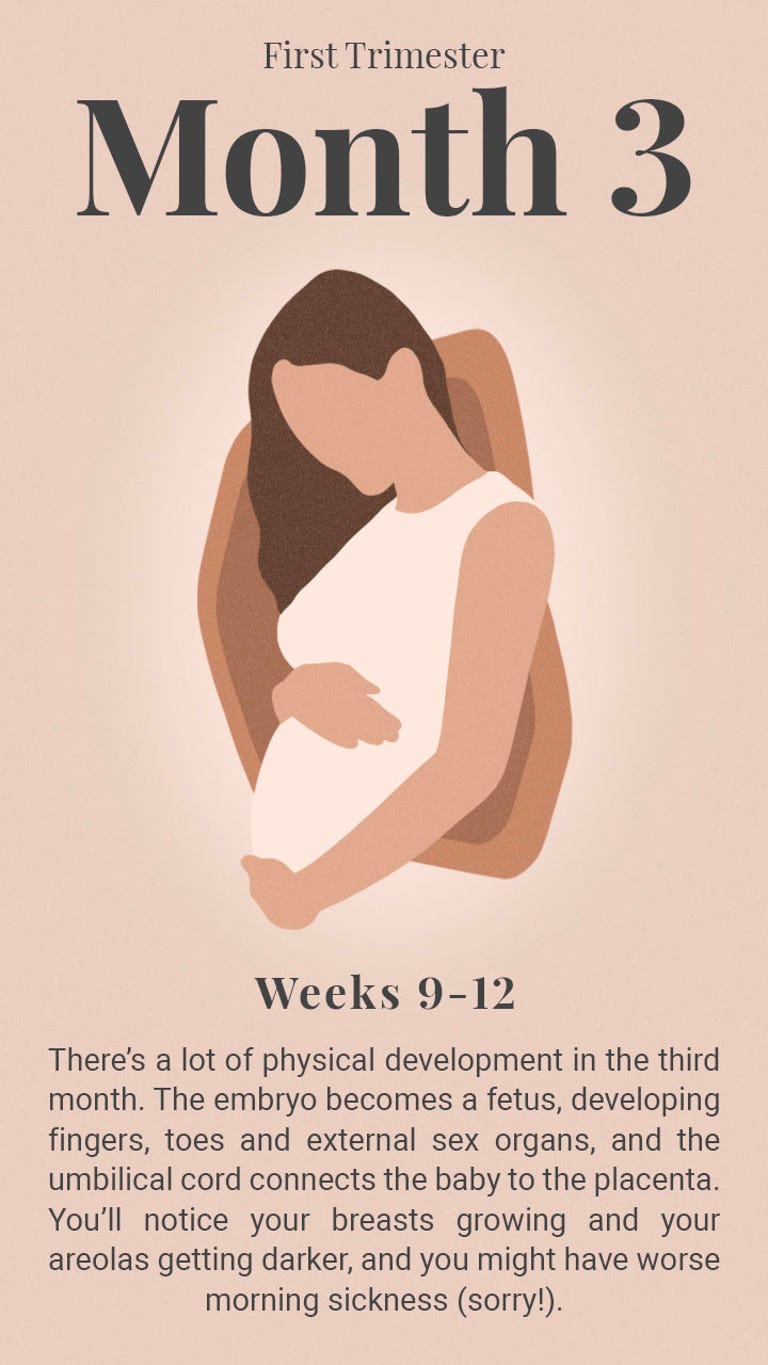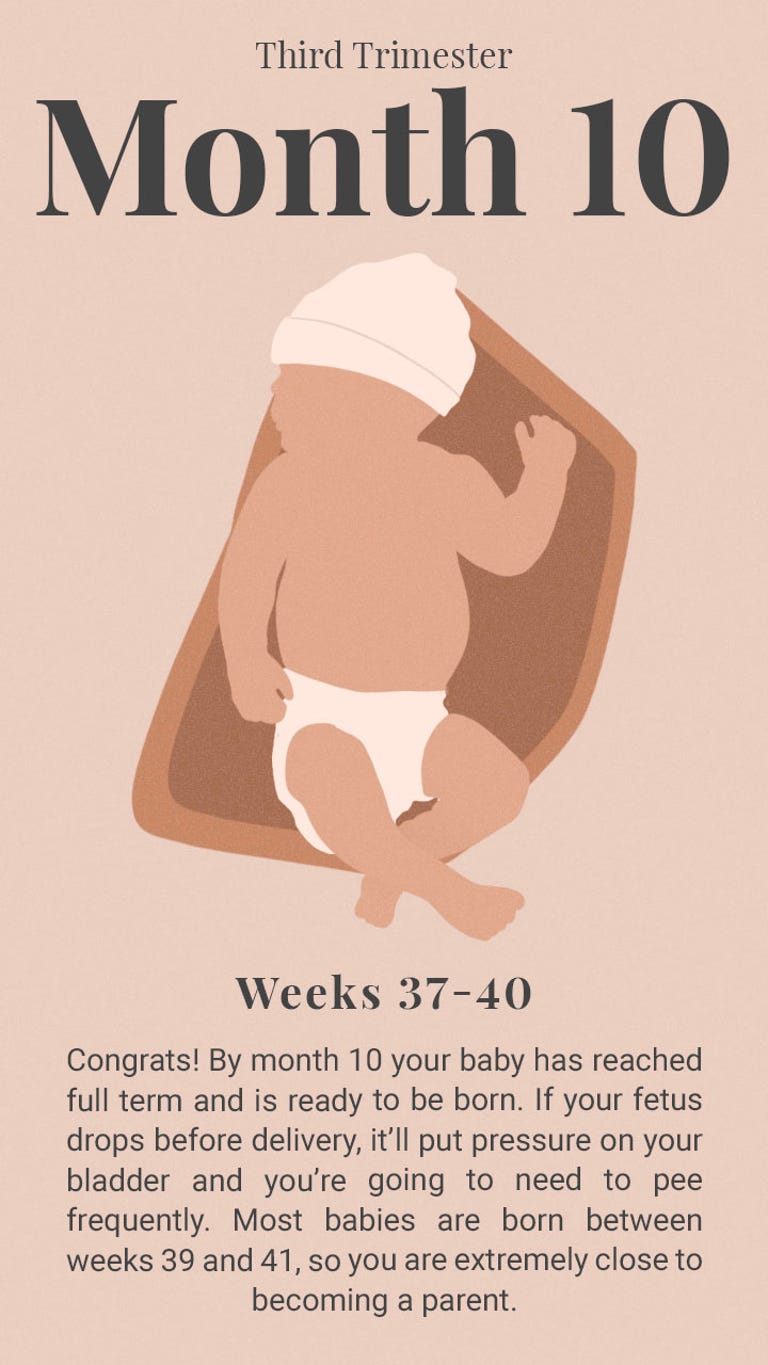Pregnancy Timeline: What Happens Each Month and the Third Month

Pregnancy, for most (if not all) women, is a mixture of excitement and dread at the same time. You can’t wait to hold your baby in your arms after 9 months but you also feel anxious about all the changes your body is going through inside and out. Pregnancy symptoms keep changing and changing, so it can be scary trying to figure out what’s normal and what’s not. Below we describe the stages of pregnancy month by month to explain what to expect in your body and how your baby is growing along the way.
Remember that each person’s body is different and may not have all the symptoms and changes described below. You should always consult your doctor if you have any questions or concerns about your pregnancy.
Check out our virtual pregnancy timeline and read on for a detailed guide to pregnancy by month and trimester.
First trimester
Did you know that the first month of pregnancy begins on the first day of menstruation? While most people take a pregnancy test at home (after missing a period or before it starts), you are usually checked at 4-5 weeks pregnant in the medical community.
Month 1 (weeks 1 to 4)
During your first month of pregnancy, you may not notice any obvious symptoms. Another telltale sign for others is seeing light, which can indicate that the embryo is attached to the wall of your uterus. First month symptoms include feeling more tired than usual, having to urinate more often, tender or sore breasts and morning sickness.
The process of conception begins when an egg unites with a single sperm, creating a zygote. The zygote begins to divide and become an embryo as it travels down the fallopian tubes and attaches to the uterine wall — a process that takes several days. If it sticks successfully, you are pregnant. If not, you will have a period, shed the lining of the uterus and the fetus.
Month 2 (Weeks 5 to 8)
By month 2, you may have seen an obstetrician and had an ultrasound to see the growing fetus. If you didn’t have symptoms in the first month, you will feel them now. Expect morning sickness, tender breasts, heartburn and a racing heart because your body is producing more blood to support the baby.
Your baby is going through a lot of changes this month. The heart expands and begins to beat. The beginnings of the spine, brain and nervous system begin to form, the navel grows and the buds of arms and legs sprout. Fingers, toes, eyes and ears also begin to form, towards the end of the second month.

Month 3 (Weeks 9 to 12)
Congratulations, you’ve reached month 3! This is the time that many parents will be the first to tell friends and family because the risk of miscarriage is greatly reduced.
The downside is that second month symptoms can be worse (sorry). You will notice that your breasts are getting bigger and areolas are getting darker. If you have acne, you may experience more breakouts this month.
In the third month, the embryo becomes a fetus. This is the time when the internal sex organs develop into their final forms — be it the ovaries and uterus or the testicles and penis. The first bones that started forming last month are starting to harden and all the organs are already forming.
Second trimester
The second trimester is hailed as the best part of pregnancy, because the symptoms of the first trimester begin to subside — goodbye, morning sickness! (MaybeYour baby is now fully grown, but will continue to grow and develop new features, such as hair and fingerprints.
Month 4 (weeks 13 to 16)
You are probably halfway through your pregnancy now, and you may be able to determine the gender of the baby with an ultrasound. Your heart is still pumping faster to deliver more blood to you and the baby, so it’s normal to feel dizzy or short of breath. That extra blood can cause bleeding or bleeding gums. You may also experience bloating, back pain and start to see a small baby bump forming.
Month 5 (Weeks 17 to 20)
Although you may not get full kicks, in the 5th month, you will begin to feel movement as your fetus moves through the womb. Muscles grow and hair begins to grow on the baby’s head.
Expect the same symptoms as month 4: heartburn, bloating and shortness of breath. You will probably need new bras as your breasts go up a cup size or two.

Month 6 (weeks 21 to 24)
Your baby will be moving a little more now: You will start to hear him hiccup, kick and move around in the womb. You may notice more bloating, bleeding gums and leg cramps than before. You may also start producing colostrum, the first stage of making breast milk.
Braxton-Hicks contractions can appear in the sixth month. These contractions are usually painless and normal — it’s just your body preparing for labor. But if they hurt or happen more often, call your doctor.
The medical community generally considers a fetus to be viable (meaning it can live outside the womb with medical intervention) at 24 weeks. Even with that intervention, there is a high risk that the child will not survive.
A fetus born before 24 weeks can survive, but only with special medical care. Even then, the baby has only about a 6 percent chance of survival.
Month 7 (weeks 25 to 28)
The seventh month of pregnancy will probably be no different than the 6th month. You will have the same symptoms as before and you should have a visible baby bump by now.
Your baby is starting to gain body fat and his ears are fully developed, so he will respond to sounds and music. This is also the stage where you can have a premature baby and it is possible for him to survive with medical care. Babies are still considered “very premature” before 28 weeks and are at high risk of long-term health problems.
The third trimester
This is a home building; it’s still a few months until you meet your baby. During this time, your body begins to prepare for labor and delivery.
Month 8 (weeks 29 to 32)
Right now, she’s feeling the effects of carrying a baby almost completely, including back pain and loose joints. Your belly will probably have stretch marks as your fast growing fetus makes your belly grow faster. Your uterus will start to put pressure on your bladder, which means you will have to urinate more often.
The result? Those pregnancy hormones make your hair look fuller and healthier.

Month 9 (33 to 36 weeks)
You’re about to arrive! In the ninth month, you will feel the same symptoms as the 8th month, including varicose veins, stretch marks and fatigue. Because your belly is at its largest, you may have trouble sleeping comfortably (some pregnancy tests can help with this).
Your baby is now fully grown with functioning lungs and joint intelligence. They can live outside the womb just fine.
Month 10 (Weeks 37 to 40)
Popular tradition says that pregnancy lasts nine months, but most people actually give birth between nine and 10 months. Forty weeks is considered full term, but babies can be born later than that.
Congratulations! In the 10th month your baby is ready to be born. If your fetus descends before delivery, it will put more pressure on your bladder and you will have to urinate more often. Be aware of signs of labor, such as contractions that occur on a consistent schedule. Most babies are born between 39 and 41 weeks, so you are very close to becoming a parent.




/cdn.vox-cdn.com/uploads/chorus_asset/file/25728924/STK133_BLUESKY__B.jpg?w=390&resize=390,220&ssl=1)